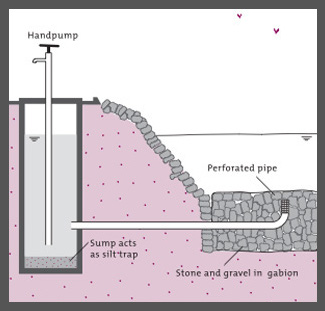Difference between revisions of "Water Portal / Rainwater Harvesting / Surface water / Sump intake"
(→Construction, operations and maintenance) |
(→Reference manuals, videos, and links) |
||
| Line 36: | Line 36: | ||
==Costs== | ==Costs== | ||
| − | == | + | ==Manuals, videos, and links== |
==Acknowledgements== | ==Acknowledgements== | ||
* Brikke, François, and Bredero, Maarten. ''[http://www.google.com/url?sa=t&rct=j&q=&esrc=s&source=web&cd=2&ved=0CC0QFjAB&url=http%3A%2F%2Fwww.who.int%2Fwater_sanitation_health%2Fhygiene%2Fom%2Flinkingintro.pdf&ei=cwJpT-zaO-OiiQKCst2rBw&usg=AFQjCNEWOQhTgF3a7lzhuw5OA2KmbVGxcA&sig2=Rt2EURUyGVqDcwFg6p0xAw Linking technology choice with operation and maintenance in the context of community water supply and sanitation: A reference document for planners and project staff]''. World Health Organization and IRC Water and Sanitation Centre. Geneva, Switzerland 2003. | * Brikke, François, and Bredero, Maarten. ''[http://www.google.com/url?sa=t&rct=j&q=&esrc=s&source=web&cd=2&ved=0CC0QFjAB&url=http%3A%2F%2Fwww.who.int%2Fwater_sanitation_health%2Fhygiene%2Fom%2Flinkingintro.pdf&ei=cwJpT-zaO-OiiQKCst2rBw&usg=AFQjCNEWOQhTgF3a7lzhuw5OA2KmbVGxcA&sig2=Rt2EURUyGVqDcwFg6p0xAw Linking technology choice with operation and maintenance in the context of community water supply and sanitation: A reference document for planners and project staff]''. World Health Organization and IRC Water and Sanitation Centre. Geneva, Switzerland 2003. | ||
* [http://www.bvsde.paho.org/eswww/tecapropiada/otratec/waterlin/tb22.pdf Waterlines.] | * [http://www.bvsde.paho.org/eswww/tecapropiada/otratec/waterlin/tb22.pdf Waterlines.] | ||
Revision as of 20:16, 8 November 2012
In a sump intake (a deeper intake than other intakes), water from a river or lake flows through an underwater pipe to a well or sump from where it is lifted, usually into the initial purification stages of a drinking-water system. The inflow opening of the underwater pipe is located below the low-water level and is screened. A well provides a place for sedimentation to settle and protects the pump against damage by floating objects. To facilitate cleaning, two sump intakes are sometimes built for one pump.
A well-type pump may be set in a sump, with the inlet pipe through the river bank. In a simple intake, the pipe can be surrounded with a protective stone covering. In target intakes a pier can be used to provide access to the intake, for instance to operate a valve or clean the screen. The pier also provides some protection, and could be fitted with a bar screen to exclude debris from the intake. A duplicate inlet pipe, sump and pump may be provided to make it easier to de-silt the sump and maintain the pump.
Contents
Suitable conditions
On the banks of rivers and lakes.
Sites on the inside of bends should be avoided, to reduce sediment deposition and inflow.
Problems can arise if the river bed is unstable (for example, gravel), or the river is very shallow at low flows. It can be difficult to set the intake level to be safe from silting up during floods, but still able to abstract water at low flows. A Tyrolean weir can assist with this or a Floating intake can be used.
Resilience to changes in the environment
Drought effects on cement
Effects of drought: Badly made concrete or cracked linings (e.g. in tanks, dams, waterways, wells, and other structures).
Underlying causes of effects: Less water used for curing; Impure water used for mixing.
To increase resiliency of WASH system: Ensure adequate mixing, ratios, purity of ingredients; Minimize water content in mixture; Ensure adequate curing.
More information on managing drought: Resilient WASH systems in drought-prone areas.
Construction, operations and maintenance
Operation is usually carried out by a caretaker. The sump must be checked daily for sufficient water inflow; any debris obstructing it must be removed, and any damage repaired. Most of the maintenance will be to the pump. The intake itself needs some cleaning and de-silting. If it caves in, or if the river or lake bank erodes, repairs have to be made. A sump inlet does not require special organizational arrangements.
Potential problems
— silt or debris clogs the inlet pipe;
— erosion caused by the river current undermines the intake structure and the bank;
— the water quality from the river or lake is poor;
— a sump intake is unsuitable for rivers that are very shallow or that have low flow rates.
Costs
Manuals, videos, and links
Acknowledgements
- Brikke, François, and Bredero, Maarten. Linking technology choice with operation and maintenance in the context of community water supply and sanitation: A reference document for planners and project staff. World Health Organization and IRC Water and Sanitation Centre. Geneva, Switzerland 2003.
- Waterlines.


